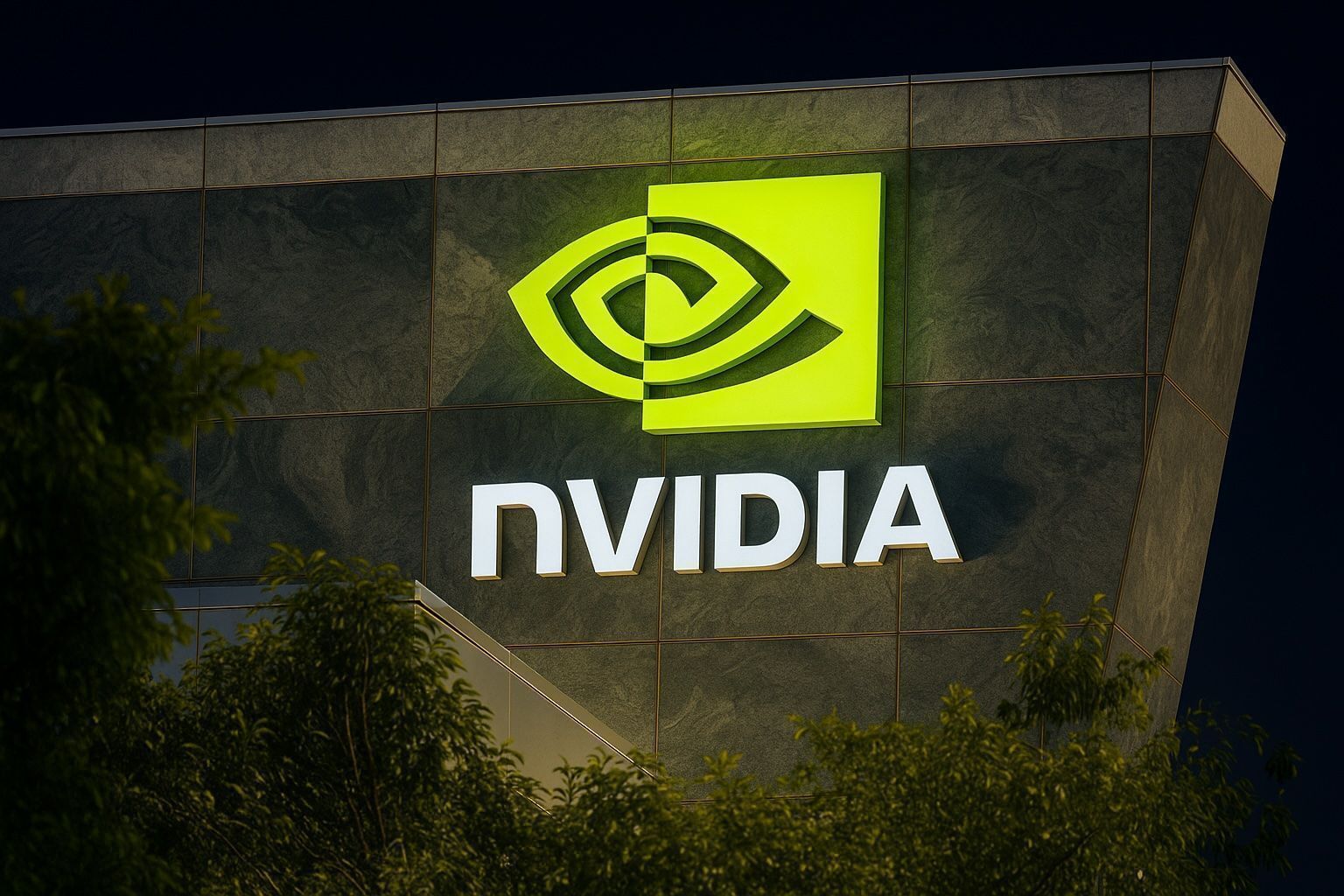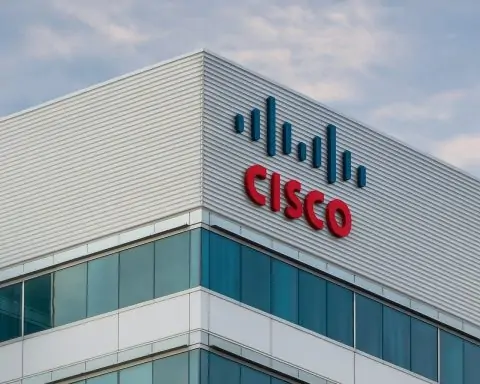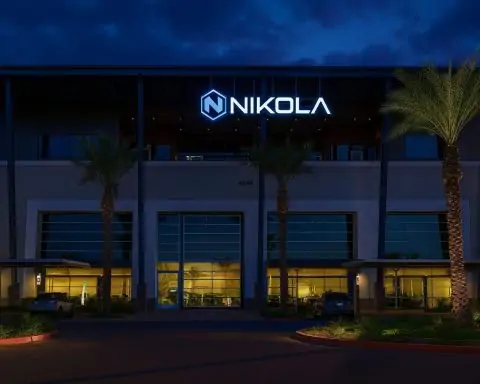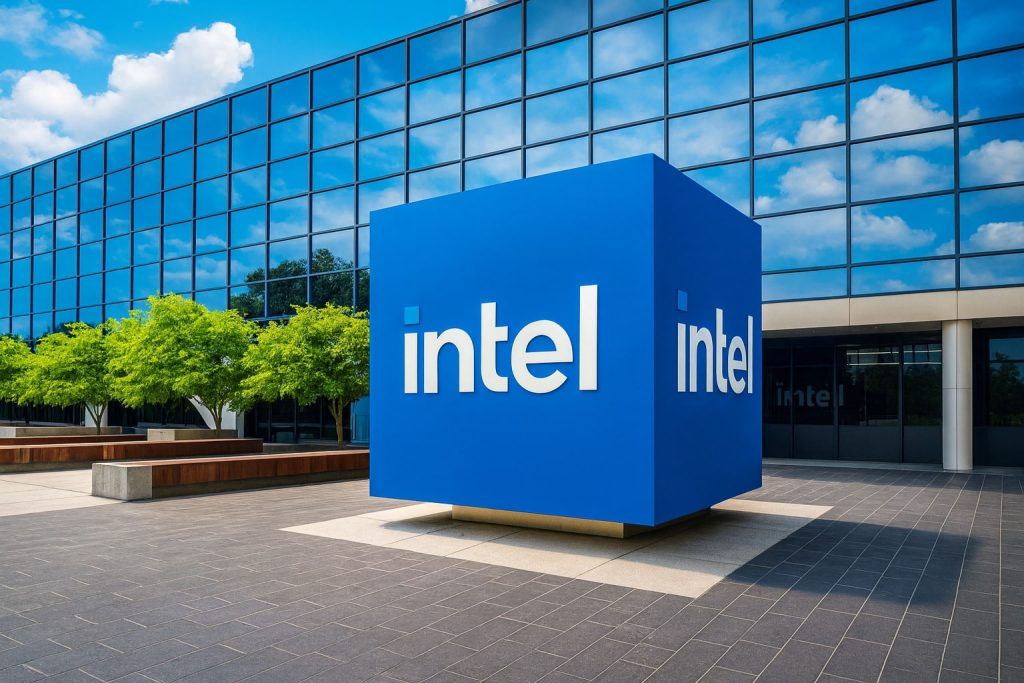- NVDA stock jumps: Nvidia’s share price closed around $190.7 on Oct. 27, 2025, up about 2.8% for the day amid a broad market rally [1]. The stock is roughly 30% higher year-to-date, vastly outperforming the S&P 500 [2].
- Record valuation: Nvidia briefly hit a $4 trillion+ market cap in early October – at one point becoming the world’s most valuable public company [3]. This was fueled by blockbuster earnings (56% YoY revenue growth last quarter) and surging AI chip demand [4].
- AI mega-deals: In recent weeks Nvidia unveiled a $100 billion partnership with OpenAI to supply ~10GW of GPUs [5], invested $5 billion in Intel to co-develop next-gen chips [6], and joined a $40 billion consortium (with BlackRock, Microsoft, etc.) to acquire Aligned Data Centers (adding ~5GW of AI capacity) [7]. These moves aim to secure years of AI-driven growth.
- Rivals & new chips: Competition is heating up. Qualcomm stock soared 11% after unveiling AI chips to challenge Nvidia in data-center markets [8] [9]. AMD inked a deal to supply OpenAI ~6GW of GPUs and even gave OpenAI an option for a 10% stake – AMD’s stock surged 34% on the news [10]. Analysts note Nvidia still “sells every AI chip it can make,” but the AI hardware pie is expanding for multiple players [11].
- Wall Street bullish: About 80–90% of analysts rate NVDA a “Buy,” with an average 12-month price target in the $210–$220 range [12] [13] (~15% above current levels). Some top bulls, like HSBC, have raised targets to $320 (nearly +70% upside) citing Nvidia’s dominant AI position [14].
- Valuation & risks: Nvidia trades around 50× earnings – a rich valuation that leaves “little room for error” [15]. One contrarian analyst (Jay Goldberg) calls the AI boom “not my first bubble,” warning that frenzied AI capex could eventually “tumble down” like the dot-com era; he is the lone NVDA bear with a $100 target [16] [17]. Short-term, investors remain upbeat, but export curbs and U.S.–China tensions cloud ~10–15% of Nvidia’s revenue from China [18].
NVDA Stock Surges Amid AI Optimism
Nvidia’s stock rallied at the start of this week, gaining nearly 3% on Monday to ~$190.7 [19]. The jump outpaced broader indexes, as optimism about a potential U.S.-China trade deal and cooling inflation lifted tech shares to record highs [20] [21]. Nvidia’s Monday gain helped extend its year-to-date climb to about +30%, vastly outperforming the S&P 500’s returns [22]. Shares are only a few points shy of the all-time intraday peak (~$195.62) reached in early October [23]. Back then, euphoric buying amid the AI boom briefly boosted Nvidia’s market capitalization above $4 trillion – even surpassing Apple to be the world’s most valuable company for a moment [24]. While some profit-taking knocked NVDA off those highs in mid-October (the stock dipped ~4% from its peak on broader tech weakness) [25] [26], investor sentiment remains robust. Heavy trading volumes and swift “buy the dip” flows into Nvidia highlight its status as the market’s premier “AI play,” sensitive to every twist in sentiment [27].
Wall Street’s risk-on mood this week was buoyed by macro news that favored growth stocks like NVDA. U.S. negotiators reported progress in trade talks with China, with President Donald Trump and President Xi Jinping set to meet, fueling hopes of eased tariffs [28]. At the same time, tepid inflation data reinforced expectations that the Federal Reserve will cut interest rates soon [29]. This combination – potential trade détente and a friendlier rate outlook – provided a perfect tailwind for high-valuation tech leaders. Nvidia, often seen as a bellwether for the AI-driven rally, climbed alongside other megacap stocks. Notably, fellow “Magnificent Seven” members Amazon, Apple, Google, Meta, and Microsoft all rose 1%–3.5% on the day [30]. “Optimism around US-China [relations]…buys time” for the pro-AI, pro-risk rally to continue, Reuters noted [31]. In short, the market’s AI enthusiasm remains intact heading into a pivotal stretch of tech earnings and central bank decisions.
Blowout Earnings and AI Mega-Deals Fuel Growth
Nvidia’s fundamentals have validated much of the hype. In its latest reported quarter (FY2026 Q2, covering May–July 2025), revenue soared 56% year-on-year to $46.7 billion [32] – a record surge for a company of Nvidia’s size. A staggering ~88% of sales ($41 billion) came from the data-center segment, i.e. the high-end GPUs powering today’s AI models [33] [34]. Profitability also ballooned, with gross margins around 72% and net margins above 50% [35] [36]. These “blowout” results far exceeded expectations and prompted Nvidia to guide for ~54% YoY growth next quarter (projecting roughly $54 billion in Q3 revenue) – “an unheard-of pace at this scale” [37]. Investors cheered the numbers, sending the stock higher on confidence that the AI boom has legs [38]. Nvidia is scheduled to report its next earnings on November 19, and another blockbuster quarter is anticipated [39]. All eyes will be on whether demand for AI hardware is still outstripping supply, as CEO Jensen Huang has often indicated.
Crucially, Nvidia has moved aggressively to lock in future growth through partnerships and investments. In late September, the company and OpenAI announced a landmark deal – a potential $100 billion tie-up to build OpenAI’s next-gen supercomputing infrastructure [40]. Nvidia will invest up to $100B in OpenAI (for non-voting equity) and supply at least 10 gigawatts of its cutting-edge GPUs to OpenAI in coming years [41] [42]. “Everything starts with compute,” OpenAI CEO Sam Altman said, underscoring that Nvidia’s hardware will remain “at the heart of future AI breakthroughs” [43]. The news of this massive pact – effectively guaranteeing OpenAI’s GPU purchases – lifted Nvidia’s stock ~4% on the day [44]. Analysts estimate each gigawatt of AI data center capacity could translate to ~$50 billion in hardware sales [45], implying the OpenAI deal alone might ultimately be worth $500 billion in long-term revenue opportunity [46].
Around the same time, Nvidia struck an unprecedented alliance with Intel. It committed $5 billion for a stake in Intel and to jointly develop next-generation CPU–GPU systems [47]. Under this partnership, Intel will produce custom x86 processors integrated via Nvidia’s NVLink with Nvidia GPUs [48]. This bridges Nvidia’s AI accelerators with Intel’s server CPUs – a “win-win” that leverages each company’s strengths. The unusual teaming of rivals sent Intel shares up 23% and boosted NVDA ~3.8% on the announcement [49]. Nvidia has also been busy expanding physical AI infrastructure. In mid-October, it joined a BlackRock-led consortium to acquire Aligned Data Centers for $40 billion, gaining ownership of ~80 data centers (over 5GW capacity) critical for cloud AI computing [50] [51]. “With this investment…we further our goal of delivering the infrastructure to power the future of AI,” BlackRock’s CEO Larry Fink said of the deal [52]. Separately, Nvidia partnered with Japan’s Fujitsu to build out national AI infrastructure, with Huang lauding the creation of “the infrastructure to power [the] AI industrial revolution…in Japan and across the globe” [53].
Nvidia isn’t neglecting product innovation either. It recently launched the GeForce RTX 50-series GPUs for consumers, featuring AI-enhanced graphics capabilities [54]. For enterprise and research customers, Nvidia began shipping “DGX Spark,” billed as the world’s smallest AI supercomputer, condensing enormous compute power into a portable form factor [55]. The company also open-sourced new AI tools in robotics – such as the Newton GPU physics engine (developed with Google DeepMind and Disney) – aiming to give robots “a brain, a body and a training ground” in simulation [56]. Nvidia’s executives have touted humanoid robots as the “next frontier of physical AI,” hinting at the long-term opportunities beyond chips [57]. All told, through breakneck product launches and strategic deals, Nvidia is reinforcing its leadership in the AI era and securing demand for years to come.
Rivals Step Up: Competition in the AI Chip Race
So far, Nvidia has enjoyed near-monopoly status in cutting-edge AI accelerators – but the competitive landscape is intensifying. Other chipmakers and tech giants are racing to capture a slice of the surging AI hardware market. Advanced Micro Devices (AMD) in particular made waves this month by striking a major deal with OpenAI, directly challenging Nvidia on its home turf. According to Reuters, AMD agreed to supply OpenAI with roughly 6 gigawatts of AI GPU capacity (likely via its MI300 series accelerators) starting in 2026 [58]. In a bold twist, OpenAI was also granted an option to acquire up to 10% of AMD as part of the partnership [59]. The news — effectively aligning OpenAI with AMD as both a customer and stakeholder — sent AMD’s stock skyrocketing 34% in a single day (Oct. 6), the chipmaker’s biggest one-day jump in 9 years [60]. AMD followed up by announcing that Oracle’s cloud will deploy 50,000 of AMD’s next-gen MI450 GPUs by 2026 [61]. This string of wins for AMD signaled to investors that Nvidia will not go unchallenged in the AI silicon realm. Even Broadcom has joined the fray: OpenAI struck a deal with Broadcom to co-develop custom AI chips (targeting 10GW capacity) in-house by 2026 [62].
More recently, Qualcomm has thrown its hat in the ring. On Oct. 27, Qualcomm unveiled a new lineup of AI chips and systems aimed at data centers – directly “aiming to challenge Nvidia in the fastest-growing part of the industry,” as Bloomberg described [63]. Qualcomm’s move into AI accelerators is notable since the company is known for mobile chips; the expansion to lucrative server AI silicon could pose a longer-term competitive threat. Investors reacted with enthusiasm: Qualcomm shares surged to their highest price in 15 months after the announcement [64], jumping about 11% on Monday to top the S&P 500’s leaderboard [65]. Qualcomm’s new chips target “inference” – the deployment of AI models – which could undercut Nvidia’s grip on that market segment if they gain traction [66].
Despite these emerging rivals, analysts maintain that Nvidia’s dominance in AI chips remains firmly intact for now. The company’s H100 and A100 GPUs are still regarded as the gold standard for training large AI models, and demand far exceeds Nvidia’s supply capacity. “These moves won’t dethrone Nvidia’s dominance – Nvidia still sells every AI chip it can make,” noted one investment report, “but [they] show the AI pie is expanding for multiple players” [67]. In other words, competitors like AMD and Qualcomm are rising mainly because the overall market is booming, not because Nvidia is losing its edge. Indeed, Nvidia’s own fortunes may be helped by broader adoption of AI: for example, its recent tie-up with Intel suggests even erstwhile rivals are now partnering to ride the AI wave together. Still, the race is on. Industry observers say 2024–2026 will bring an explosion of new AI chips (from startups and incumbents alike), and big cloud firms like Amazon, Google, and Meta are also developing in-house AI silicon. Nvidia faces the task of innovating rapidly to defend its lead. The upshot for investors is that while Nvidia is the clear front-runner, the AI hardware space is no longer a one-horse show – a development that bears watching for its impact on Nvidia’s longer-term market share and pricing power.
Market Sentiment: Bulls Euphoric but Bubble Fears Linger
Wall Street’s consensus on Nvidia remains resoundingly bullish. Of the roughly 47–80 analysts covering NVDA, the vast majority (around 38 out of 47, or over 70 out of 80 in some counts) rate it a “Buy” [68] [69]. The average 12-month price target sits around $210–$220 per share [70] [71], about 15–20% above current levels. Many analysts have been raising their targets as Nvidia continues to trounce expectations; for instance, HSBC’s Frank Lee recently hiked his NVDA target to $320 – implying almost 80% upside – citing “massive AI chip demand” and Nvidia’s unrivaled position to capitalize [72] [73]. Some bullish forecasters have even floated the possibility that Nvidia could become the first $10 trillion company in the coming years if the AI revolution continues unabated [74]. “Don’t sleep on Nvidia,” one upbeat analyst urged, emphasizing its pivotal role enabling the AI ecosystem [75].
At the same time, there is a growing undercurrent of caution even among supporters. A few analysts (albeit a small minority) have pointed out that Nvidia’s valuation is extremely rich, which could make the stock vulnerable if growth slows. At ~$190/share, Nvidia trades around 50× trailing earnings (about 33× forward earnings) – far above the semiconductor industry average [76]. This lofty multiple bakes in huge expectations. “Valuations near 50× earnings leave little room for error,” one market note warned [77]. Susquehanna analyst Chris Rolland, while still bullish on Nvidia near-term, cautioned that the company might “have a flat growth year” within a couple of years – a scenario that could shock investors used to meteoric gains [78]. The risk is that at some point the AI spending cycle could normalize, testing whether Nvidia’s stock price is justified by sustainable results.
Notably, one veteran analyst has gone outright bearish on Nvidia. Jay Goldberg of DIGIT Capital is “the only one with a sell rating” on the stock, according to Bloomberg [79]. “There’s a lot more that can go wrong with Nvidia than can go right,” says Goldberg, who argues that the current AI investment frenzy bears an uncanny resemblance to the dot-com bubble of the late 1990s [80] [81]. He points out that titans like Microsoft, Google, Amazon, Meta, Oracle – along with OpenAI – are collectively pouring hundreds of billions into AI infrastructure, driving Nvidia’s valuation to stratospheric heights [82]. But if the anticipated “return on AI” doesn’t materialize commensurately, this spending could sputter out. “This is not my first bubble,” Goldberg says, recalling how Cisco Systems soared during the telecom buildout of 1999–2000 only to crash when demand failed to meet lofty expectations [83]. He sees a similar pattern brewing: “We’re going to build up all this AI stuff for what are largely psychological reasons… At some point, the spending will stop, and the whole thing will tumble down, and we’ll reset.” [84] Goldberg’s price target is just $100 [85], roughly half of NVDA’s current price – reflecting his view that the stock’s risk/reward is skewed sharply downward. While few share such a grim outlook today, his stance highlights the debate over whether Nvidia’s valuation is in a bubble or justified by its growth trajectory. For now, the optimists are in command, but even Nvidia’s biggest fans concede that execution needs to remain flawless to support its $1+ trillion valuation.
Geopolitical & Economic Wildcards: Trade, China Curbs, and Outlook
Beyond company-specific factors, several macro and geopolitical forces are influencing Nvidia’s narrative. In the short run, as seen this week, hopes for a thaw in U.S.–China relations have been a boon for market sentiment [86] [87]. Any positive steps toward a trade agreement or reduced tariffs could help Nvidia by improving global economic conditions (and potentially easing restrictions on tech trade). Indeed, reports that China might delay imposing new rare-earth export restrictions – key materials for chips – gave an extra boost to chip stocks on Monday [88]. Additionally, signs of cooling inflation and the prospect of the Federal Reserve cutting interest rates are especially beneficial for high-growth, high-multiple stocks like NVDA [89]. Lower rates would reduce the discount on future earnings and make Nvidia’s lofty valuation a bit easier to justify. In essence, the more benign the macro backdrop, the longer Nvidia’s stock could ride the AI wave without external turbulence.
However, Nvidia also faces geopolitical headwinds, particularly with China. The U.S. government has imposed strict export controls on advanced AI chips to Chinese customers, citing national security concerns. Nvidia has had to create “China-only” versions of its top GPUs (with capped performance) to continue selling in that market [90]. Even so, sales to China (which historically made up ~20% of Nvidia’s data center revenue) are under pressure. Beijing has retaliated against U.S. measures – in September, China’s regulators ordered domestic tech firms to halt purchases of Nvidia’s AI chips like the H100, accusing Nvidia of monopolistic behavior [91]. Chinese customs officials have also reportedly tightened inspections to slow the import of Nvidia chips [92]. All this creates uncertainty for Nvidia: roughly 10–15% of its revenue is at stake with Chinese customers [93]. On a positive note, there have been some exceptions – the U.S. recently granted Nvidia licenses to export certain AI chips to other regions (e.g. some H20 processors to UAE) and there’s speculation about adjustment of rules [94]. But the overall trajectory of U.S.–China tech tensions remains a risk factor. Each new round of export curbs or Chinese countermeasures could cap Nvidia’s upside or complicate its supply chain. As a result, Nvidia’s executive team has ramped up engagement with policymakers; CEO Jensen Huang even showcased Nvidia’s AI advancements in Washington, D.C., as part of an “AI road show” to educate lawmakers with the U.S. preparing new tech policies [95] [96].
Looking ahead, investors will be monitoring how these macro issues play out alongside Nvidia’s own execution. In the near term, the focus is on Nvidia’s upcoming earnings (mid-November) and whether the company can extend its streak of blockbuster results. Any guidance on data center demand – especially orders from major cloud players and any impact from China – will be pivotal for the stock’s direction. The broader market tone, influenced by interest rate decisions and geopolitical news, will also continue to sway NVDA’s high-flying stock. Longer term, the questions include: Can Nvidia sustain its torrid growth as the AI frenzy matures? Will competition or geopolitical barriers materially erode its dominance? For now, Nvidia’s story is one of extraordinary growth and ambition, set against the backdrop of an AI revolution that it both benefits from and helps drive. The stock’s journey in late 2025 encapsulates this thrill and uncertainty: hitting record highs on AI euphoria, whipsawing on sentiment shifts, yet ultimately ending October with considerable momentum. As one market strategist put it, “optimism prevails” for Nvidia at this stage [97] – but the company will need to keep delivering innovation and navigate challenges deftly to justify the hype in 2026 and beyond.
Sources: Bloomberg [98] [99]; Reuters [100] [101]; TS2/TechStock² [102] [103]; Yahoo Finance/Investopedia [104] [105]; Cryptopolitan [106] [107]; CNBC; Yahoo Finance [108].
References
1. www.investopedia.com, 2. ts2.tech, 3. ts2.tech, 4. ts2.tech, 5. ts2.tech, 6. ts2.tech, 7. ts2.tech, 8. www.investopedia.com, 9. www.bloomberg.com, 10. ts2.tech, 11. ts2.tech, 12. ts2.tech, 13. ts2.tech, 14. ts2.tech, 15. ts2.tech, 16. www.cryptopolitan.com, 17. www.cryptopolitan.com, 18. ts2.tech, 19. www.investopedia.com, 20. www.investopedia.com, 21. www.reuters.com, 22. ts2.tech, 23. ts2.tech, 24. ts2.tech, 25. ts2.tech, 26. ts2.tech, 27. ts2.tech, 28. www.investopedia.com, 29. www.investopedia.com, 30. www.investopedia.com, 31. www.reuters.com, 32. ts2.tech, 33. ts2.tech, 34. ts2.tech, 35. ts2.tech, 36. ts2.tech, 37. ts2.tech, 38. ts2.tech, 39. ts2.tech, 40. ts2.tech, 41. ts2.tech, 42. www.reuters.com, 43. ts2.tech, 44. ts2.tech, 45. ts2.tech, 46. ts2.tech, 47. ts2.tech, 48. ts2.tech, 49. ts2.tech, 50. ts2.tech, 51. www.reuters.com, 52. www.reuters.com, 53. ts2.tech, 54. ts2.tech, 55. ts2.tech, 56. ts2.tech, 57. ts2.tech, 58. ts2.tech, 59. ts2.tech, 60. ts2.tech, 61. ts2.tech, 62. ts2.tech, 63. www.bloomberg.com, 64. www.bloomberg.com, 65. www.investopedia.com, 66. www.bloomberg.com, 67. ts2.tech, 68. ts2.tech, 69. www.cryptopolitan.com, 70. ts2.tech, 71. ts2.tech, 72. ts2.tech, 73. ts2.tech, 74. ts2.tech, 75. ts2.tech, 76. ts2.tech, 77. ts2.tech, 78. ts2.tech, 79. www.cryptopolitan.com, 80. www.cryptopolitan.com, 81. www.cryptopolitan.com, 82. www.cryptopolitan.com, 83. www.cryptopolitan.com, 84. www.cryptopolitan.com, 85. www.cryptopolitan.com, 86. www.investopedia.com, 87. www.reuters.com, 88. www.investopedia.com, 89. www.investopedia.com, 90. ts2.tech, 91. ts2.tech, 92. ts2.tech, 93. ts2.tech, 94. ts2.tech, 95. itif.org, 96. www.bloomberg.com, 97. ts2.tech, 98. www.bloomberg.com, 99. www.cryptopolitan.com, 100. www.reuters.com, 101. ts2.tech, 102. ts2.tech, 103. ts2.tech, 104. www.investopedia.com, 105. www.investopedia.com, 106. www.cryptopolitan.com, 107. www.cryptopolitan.com, 108. insights.som.yale.edu







